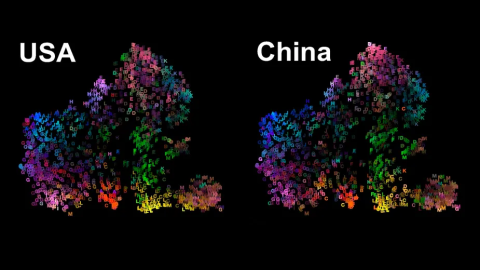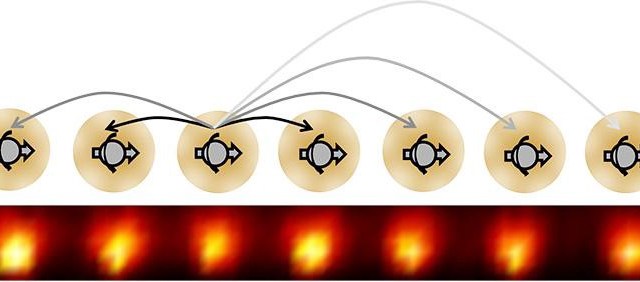This incredible interactive map plays the 13 emotions music makes us feel

- Over 2,500 people from the U.S. and China listened to the same music and were similarly affected by it.
- The study identifies a specific set of feelings that music can evoke, which you can experience in this incredible interactive map.
- Further research can use these findings to figure out how music stirs emotion in us.
“Music is a universal language, but we don’t always pay enough attention to what it’s saying and how it’s being understood,” says neuroscience doctoral student Alan Cowen of UC Berkeley and the lead author of a new study aimed at identifying the feelings music conveys. He and senior author psychologist Dacher Keltner, also of UC Berkeley, surveyed thousands of American and Chinese listeners to derive a list of 13 of music’s emotional languages, along with the types of music that evoke them. Their research has just been published in the journal Proceedings of the National Academy of Sciences, and you can experience the 13 emotions with this incredible interactive listening map.

Image source: Providence Doucet/Unsplash
The purpose of the study
In online music streaming services, a variety of methods go into the creation of playlists designed to inspire specific moods and support various activities. Human curation — and instinct — is used in some cases, while in others, algorithms based on machine learning and AI determine the songs to be included.
The power of music in evoking subjective experiences is unquestionably remarkable, but little is known about how it does what it can do. As the study puts it:
“What is not well understood is how music evokes feelings in listeners. What is the taxonomic structure of the subjective experiences that music evokes? How do people represent their experiences when hearing music? To what extent are these processes consistent or variable across cultural groups?”
What Cowen and Keltner have attempted to construct is a definitive glossary for the emotional language of music, demystifying the magic employed by both human and artificial deejays. Their hope is that their findings “can inform inquiries ranging from the etiology of affective disorders to the neurological basis of emotion.”

Tap or click these images of the American and Chinese participants’ results to interact with the researchers’ combined map, which will open in a new tab in your browser.
Image source: UC Berkeley
The study’s method and results
The researchers utilized Amazon’s Mechanical Turk platform to survey over 2,500 people living in the U.S. and in China as exemplars of listeners from two very different cultures. The respondents were presented, in two separate studies, with 2,168 music clips derived from YouTube videos.
Subjects were tasked with identifying the feeling prompted by each sample, the strength of its emotional impact — described as a level of “arousal” — and whether the feeling was positive or negative. “Imagine organizing a massively eclectic music library by emotion and capturing the combination of feelings associated with each track. That’s essentially what our study has done,” summarizes Cowen.
Though musical examples were drawn from an array of regions and musical styles — thus theoretically reducing the associative impact of cultural or geographic context — patterns emerged when the subjects’ responses were subjected to statistical analysis, revealing the 13 categories of emotion music was capable of generating:
- A: Amusing
- B: Annoying
- C: Anxious, tense
- D: Beautiful
- E: Calm, relaxing, serene
- F: Dreamy
- G: Energizing, pump-up
- H: Erotic, desirous
- I: Indignant, defiant
- J: Joyful, cheerful
- K: Sad, depressing
- L: Scary, fearful
- M: Triumphant, heroic
As part of their research, the authors have created an interactive map of the emotions they pinpointed, with each feeling denoted by the letter assigned to it in the list above. In the map, you can tap or click anywhere in the map to hear a representative music sample. This being YouTube, you’ll also see the video from which it comes, as well as an opening ad or two — the respondents were not subjected to these distractions.
Some universally got “feels”
A press release from UC Berkeley notes the emotional impacts of several well-known pieces of Western music.
- Vivaldi’s “Four Seasons” energized listeners.
- The Clash’s rousing “Rock the Casbah” got them feeling exhilarated.
- Al Green’s silky “Let’s Stay Together” and George Michael’s “Careless Whispers” got listeners feeling sensual.
- Israel (Iz) Kamakawiwoʻole’s “Somewhere over the Rainbow” and Ed Sheeran’s “The Shape of You” evoked joy.
- The infamous shower-scene music from Psycho produced chills.
- The “Star-Spangled Banner”? Pride, even if you’re from China.
None of this is especially surprising, but the question remains, how is music doing this? Considering the value of music in psychological, psychiatric, and physical therapy — not to mention the ongoing exploration into the workings of the brain — we want to know the answer, and this study may provide a helpful starting point for subsequent investigations.





